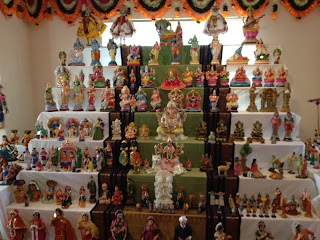Hari OM.
After meditation and opening prayers, we learned the second stanza of Ganesha Pancaratnam. We then moved on to an interesting discussion on Navaraatri.
After meditation and opening prayers, we learned the second stanza of Ganesha Pancaratnam. We then moved on to an interesting discussion on Navaraatri.
Navaraatri
The kids shared with the class how this festival is celebrated in their home. Some of them had already visited Golus, display of dolls; few others had participated in a Gaarba dance; many visited temples and friends' Golu; some of their moms had fasted and prayed; all had tasted sweets and special treats on the occasion of Navaraatri. We then learned that nava(nine) raatri(night) is a celebration spanning nine nights, praying to the Supreme Goddess: aadiparaashakti. It is believed that Goddess Lalitha Parameshwari fought a fierce battle against the demon Bandaasura. Lalitha devi's army comprised many devis: sampatkari, mantrini, varaahi, dandanaatha, etc.. Vijaya Dasami is celebrated on the tenth day when the asura was vanquished by Lalitha devi.
In south India, the first three nights are dedicated to Durga Devi, second three nights to Lakshmi Devi, and the last three nights to Saraswati Devi. The Golu usually has an odd number of steps. Why? - a girl asked, and that shall be the research topic for next class. An array of vegetables, fruits, birds, animals, men & women, mahatmas, avataars, gods, goddesses, and a kalasham are displayed in a specific order. The steps represent various forms of life from lowest to highest, and symbolically represent that as humans we have the power to ascend and become mahatmas, or realized souls. At the same time we also have the risk of descending to lower forms of life.
Kasturi Uncle had invited the fifth grade class to visit the Golu in their house. Some of us had the privilege to see the amazing display at his house.
 |
| Golu at Kasturi Uncle's House |
Ganesha Symbolism
We divided the class in to three teams: Durga, Lakshmi & Saraswati, and had a quiz on Ganesha and all the facts we had learned about. The kids were quite sharp in their memory and could recall new vocabulary words: mUrti, upaasana, upavaas, names of vedas, what Ganesha held in each of his four hands, symbolism of the trunk, mouse, etc. Good job kids, keep up the spirit.
The class then did an origami project and created a booklet, summarizing the symbolism of Ganesha. The kids really enjoyed the activity, and leaned another Ganesha shloka: "vakratunda mahaakaaya .."
Gita Vidyaarambam
We had a glorious, auspicious start to our study of Gita. We prayed as a class to Ganesha and Saraswati before beginning our study of Chapter 13. We lit a candle, an incense stick, prayed and sought blessings for our Gita study. Kasturi Uncle had brought hand-outs of chapter 13 printed in exquisite card-stock. Kids applied a mark of fresh sandalwood paste and kum-kum to the sheets. They then put them in sheet protectors and safely stored in their folder. We learned the name of the thirteenth chapter, and the first verse, which is Arjuna's question to Bhagavan Sri Krishna.
Parents! Please encourage kids to chant Gita at home. Please be their role-model and chant Gita with them, to inspire them. There is an online learning tool available to help with the chanting. These resources can be found at CMTC Gita Chanting Yajna Home Page.
Next sunday the class will meet at Mercer County Park for the CORD Walkathon. Please remember to register for the walkathon. Parents were sent emails regarding CORD Walkathon registration and information. We will have a brief Bala Vihar class at the park prior to the walk, then the kids shall walk with their family.
Well, we had so much fun in one class! We concluded the class with closing prayers and Pledge.
Eagerly waiting to see you all at the park on October 28th,
Anjana Aunty & Prasad Uncle



